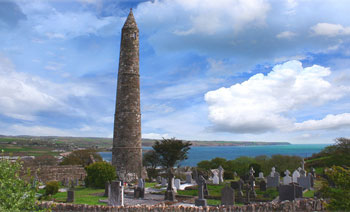Ardmore, County Waterford
51.95 - 7.725Koordinaten: 51 ° 57 ' N, 7 ° 44 ' W
Ardmore (Irish Aird Mhór ) is located on the R673 ( road ) near the south coast of Ireland in County Waterford. Its Romanesque church and especially the round tower are among the most important of its kind, the first monastery in Ardmore was founded by St. Declan ( Decclain ). He is regarded as a pillar of Christianity in southern Ireland and should already have been bishop of the church in Munster Iroschottischen when St Patrick arrived.
From 1591-93 Ardmore was owned by Sir Walter Raleigh. 1642 entrenched the Irish rebel army in the church and round tower and was besieged by the English. When she was found, were hanged on the spot 117 of 154 insurgents.
The Church
The Church of Ardmore was built by Moelettrim O Duibh - rathra before his death in 1203. Probably doing the rest of an older church was built. The church had a bishop from 1170 and has since performed as a cathedral of Ardmore. She has unusual structural features such as the Romanesque west window and the pointed chancel arch. However, the most original, the arcades and sculptures on the west wall, which are arranged above and below two rows of arcades. The scenes above a row of small arches are crumbled, but the Archangel Michael weighing the souls, can be detected. Below the large arcades, the court of Solomon, and the Adoration of the Magi are Adam and Eve, recognizable.
The Round Tower
The round tower rises five floors to a height of 30 m and is one of the best preserved in the British Isles.
The Ogham Stones
Two Ogham stones have been erected in the church ruins. One bears the inscription: "In Memory of Lugaid, son (or grandson) of Segmon Nia ( Nia also Segamain ) ". This inscription, NETA SEGAMONAS ( genitive ), possibly called in this context the name of God Segomo. The other stone bears the inscription " the only one ". One of the two Ogham stones were found built into the gable of the Oratory.
The Oratory
East of the church is the small St. Declan's Oratory, which was covered again in 1716. It is believed that this is the burial church of St. Declan. A depression in the southeast corner is shown as his grave.
Holy Well
St. Declan Holy Well belongs to a hermitage near the old monastery. The fountain dates from the 5th century and is still place of religious devotion. On July 24, many followers visit the hermitage and drink the water from the well.










